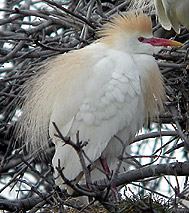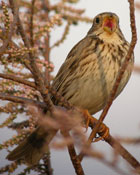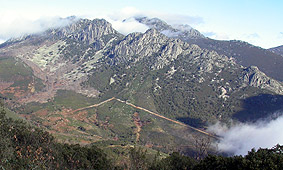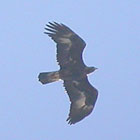 |
Spain: birds and birdwatching - part 3
by John Muddeman
Birds in inland Spain
Open pseudo-steppe habitats, including agricultural land, are also of major importance in the country, and cover vast areas, especially on the N and S plains, and along the Ebro valley. However, given ever greater mechanisation and intensification  Cattle Egret Cattle Egret
Bubulcus ibis © John Muddeman (including change to irrigated crops), this is one of the most threatened habitats at present and many of the species present are suffering significant declines. In spring and summer, Common Quail are widespread and common, both Great and Little Bustards maintain good resident populations, though the latter especially is declining rapidly, and Stone-curlew and Black-bellied and Pin-tailed Sandgrouse are also suffering the same fate. Fortunately, White Stork, which largely uses these habitats for feeding has undergone a significant recovery after serious decline in the 1980s and is now common and widespread in C and W Iberia, as is Cattle Egret in W Spain. Gaudy European Roller are still present in a few areas, Crested, Calandra and Greater Short-toed Larks, with Dupont's and Lesser Short-toed Larks along the Ebro depression, Tawny Pipit and Black-eared Wheatear are species most  Corn Bunting Corn Bunting
Miliaria calandra © John Muddeman typical of these habitats.
Numerous other species are typical and characteristic of one or several of the wide variety of Mediterranean habitats, from salt-marsh to dense woodland and steep-sided river valleys to craggy ridge-tops. Smart Red-legged Partridge are present throughout except in the highest mountains, the noisy Great Spotted Cuckoo is still quite widespread, European Scops and Eurasian Eagle Owls (surprisingly common but difficult to see!), Red-necked Nightjar, Alpine, Pallid and the rare but apparently increasing White-rumped Swift (in the SW), the exquisite European Bee-eater, showy  Villuercas mountains, Extremadura © John Muddeman Eurasian Hoopoe (wintering ever more widely), elusive Dupont's Lark in barer páramos, unobtrusive Thekla Lark, Eurasian Crag Martin, Red-rumped Swallow, Common Stonechat, Black Wheatear, Blue Rock Thrush, Dartford Warbler, Short-toed Treecreeper, Eurasian Golden Oriole, European Serin, Hawfinch and Corn, Cirl and Rock Buntings all add to the richness of the avifauna. Areas of olives and vineyards and mainly in the far SW also house the bulk of the declining Rufous-tailed Scrub Robin population. Villuercas mountains, Extremadura © John Muddeman Eurasian Hoopoe (wintering ever more widely), elusive Dupont's Lark in barer páramos, unobtrusive Thekla Lark, Eurasian Crag Martin, Red-rumped Swallow, Common Stonechat, Black Wheatear, Blue Rock Thrush, Dartford Warbler, Short-toed Treecreeper, Eurasian Golden Oriole, European Serin, Hawfinch and Corn, Cirl and Rock Buntings all add to the richness of the avifauna. Areas of olives and vineyards and mainly in the far SW also house the bulk of the declining Rufous-tailed Scrub Robin population.
Further notable mainland birds which don't fit easily into any of these categories include Little Swift (very rare in coastal Andalucía; confirmed breeding at a second site in 2004), Iberian Chiffchaff (mostly W Iberia), Bonelli's Warbler, Firecrest, Crested Tit, Lesser Grey Shrike (very rare in NE), Red-billed Chough, Iberian Azure-winged Magpie (recently proposed as a full species: C. cooki) and Common Crossbill.
 John MuddemanA professional tour guide, writer and scientific translator, with a lifelong interest in diverse aspects of natural history. He lives the Madrid mountains and guides organised groups throughout Iberia, Europe and further afield. Raptors in Spain
One of the clear highlights for a visiting bird watcher is the variety and numbers of raptors. Residents include the exquisite Black-shouldered and elegant Red Kites, numbers of the latter boosted in winter by visitors from further E and sometimes  Golden Eagle Golden Eagle
Aquila chysaetos © John Muddeman forming spectacular roosts of >400 birds! Black Kite is simply common in summer in most areas except along the coasts. Thanks to intense conservation efforts Lammergeier maintains a strong population in the Pyrenees (and is being reintroduced into Andalucía) and Eurasian Black Vulture is doing well in the SW, despite serious continuing problems with illegal poison baits affecting both species. This includes on Mallorca, which houses the only island population of the latter species known. Eurasian Griffon Vulture is a feature of much of Spain, especially the Pyrenees, pre-Pyrenees and mountain chains of the  Dehesa habitat, Extremadura © John Muddeman rest of the C and S, while the comparatively lightweight Egyptian Vulture is still quite widespread in the same areas (including resident populations on Fuerteventura, Lanzarote and Menorca) but is suffering a serious and continuous decline throughout. There is also an increasing trend for the rare Rüppell's Griffon Vulture to appear in the Strait of Gibraltar in autumn and even more rarely in other parts of the peninsula at other times. Western Marsh, Hen and Montagu's Harriers all breed locally, with numbers of the first two also boosted by migrants and winter visitors, though Montagu's appears to be suffering a serious decline in many agricultural areas. Eagles are well represented too, with the star being Spanish (now with almost 200 pairs, and 2-4 of these in Portugal), plus widespread resident Golden, rather more local and declining Bonelli's, but widespread and still relatively frequent breeding Short-toed and Booted Eagles. The latter two are also showing a tendency to overwinter in the Mediterranean region, while the last, peculiarly, is resident on Mallorca and Menorca anyway. Osprey is apparently breeding on the mainland again (in Andalucía) after reintroduction, despite moderate numbers on passage across the country and a few in winter in the SW, Dehesa habitat, Extremadura © John Muddeman rest of the C and S, while the comparatively lightweight Egyptian Vulture is still quite widespread in the same areas (including resident populations on Fuerteventura, Lanzarote and Menorca) but is suffering a serious and continuous decline throughout. There is also an increasing trend for the rare Rüppell's Griffon Vulture to appear in the Strait of Gibraltar in autumn and even more rarely in other parts of the peninsula at other times. Western Marsh, Hen and Montagu's Harriers all breed locally, with numbers of the first two also boosted by migrants and winter visitors, though Montagu's appears to be suffering a serious decline in many agricultural areas. Eagles are well represented too, with the star being Spanish (now with almost 200 pairs, and 2-4 of these in Portugal), plus widespread resident Golden, rather more local and declining Bonelli's, but widespread and still relatively frequent breeding Short-toed and Booted Eagles. The latter two are also showing a tendency to overwinter in the Mediterranean region, while the last, peculiarly, is resident on Mallorca and Menorca anyway. Osprey is apparently breeding on the mainland again (in Andalucía) after reintroduction, despite moderate numbers on passage across the country and a few in winter in the SW,  Biniés, pre-Pyrenees © John Muddeman with the relict populations on the Balearics and Canaries still remaining rather small and at risk. Lesser Kestrel is a relatively widespread summer visitor to SW and C Spain and Eleonora's Falcon also maintains a relatively healthy populations in Spain on the Balearics and a smaller population in N Lanzarote. One of the best places to see raptors in Europe is Monfragüe Natural Park in N Extremadura and the whole of this region is exceptional in the numbers and diversity of species present. Biniés, pre-Pyrenees © John Muddeman with the relict populations on the Balearics and Canaries still remaining rather small and at risk. Lesser Kestrel is a relatively widespread summer visitor to SW and C Spain and Eleonora's Falcon also maintains a relatively healthy populations in Spain on the Balearics and a smaller population in N Lanzarote. One of the best places to see raptors in Europe is Monfragüe Natural Park in N Extremadura and the whole of this region is exceptional in the numbers and diversity of species present.
|